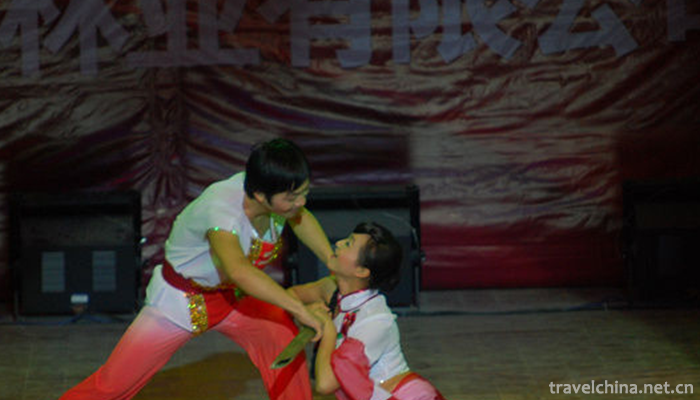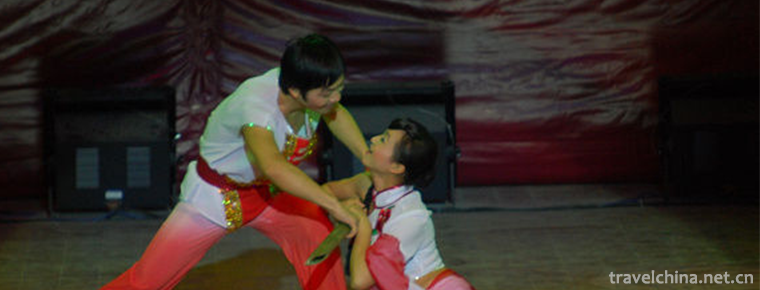Yihuanghe Bar Dance
Yihuanghe Bar Dance
Hebang dance is popular in Hedong area of Yihuang County, Jiangxi Province. It is a kind of traditional folk dance developed by mountain people from generation to generation, chopping branches on the mountain, singing and dancing in rhythm with sticks and wood knives. It has a history of more than 600 years, reflecting the wisdom and creativity of the working people. In 2014, it was selected into the fourth batch of national intangible cultural heritage list.
origin
According to Wu Jiafu, a farmer in Lanshui Township, Yihuang County, which is now merged into Zhonggang Township, the Hebang Dance evolved from Hebang Song. Hebang song is mainly composed of songs. The performance of Hebang is very simple. It takes the Hebang in hand or on shoulder and beats with a wood knife, only playing the role of beating folk songs. Later, people gradually did not satisfy this simple art form. Some people improved the pole song. They enriched the rhythm of the pole song by using the timbre and tone of the pole song became more vivid and livel Bar, while singing, while dancing, but also participate in various forms of song, so, after a long period of development, the bar song eventually evolved into the bar dance.
content
The characteristics of "Hebar Dance" are activation and laborization. With firewood knife and bars as musical instruments, the number of people can be more or less, the movement range is not large, the footsteps are natural, and more square steps are taken. Its line tone is more comfortable, word by word, rhythm is smooth, light and dexterous. It beats the bar with the wood knife in all parts to produce the ideas and rhythm of dancing and singing. The most commonly used are "5/8" and "4/8" rhythms, the content of the lyrics is irregular, the singers touch the scenery and sentiment, borrow material to express their feelings, so that the whole dance fully reflects the traditional folk customs, showing a lively local style. The most influential part of the pole dance is the pole dance, which is mainly composed of the folk song Zhuo Wangshan.
Zhuo Wangshan is a short-tuned folk song with beautiful melody. The whole tune is divided into eight sections. It is kind and simple to sing, and is deeply loved by the masses.
protect
With the diversification of cultural life style, Yihuanghe Bar Dance is also on the verge of being lost. Yihuang County organizes relevant personnel to carry out rescue excavation, collation and protection of the intangible cultural heritage in Yihuang County. The "Hebang Dance" has basically collected pictures and written materials. In 2007, Yihuang "Hebar Dance" has been listed in the first batch of city-level intangible cultural heritage list of Fuzhou.


-
2.sauteed tofu in hot and spicy sauce
sauteed tofu in hot and spicy sauce is one of the traditional dishes in Sichuan
Time 2018-10-12 -
3.Crab Dumplings in Soup
Crab yellow soup bag is a traditional snack in Jiangsu Province. The crab yellow soup bag is made of crab yellow and crab meat with stuffing
Time 2018-10-27 -
4.Henan Mayuxing Barrel Chicken
Henan Mayuxing Barrel Chicken is a famous specialty dish in Kaifeng. It is famous for its bright yellow color, salty fragrance, tender crisp, fat but not greasy
Time 2018-11-25 -
5.Shanghai Botanical Garden
Located in the southwest of Xuhui District, Shanghai Botanical Garden, formerly Longhua Nursery, is a comprehensive botanical garden with plant introduction, domestication and display
Time 2018-12-19 -
6.Nine Towers Chinese Folk Happy Garden
Jiudingta Chinese Folk Happy Garden is a large-scale original ecological and cultural tourist area which integrates Chinese national customs, scenic spots, waterfalls, recreational exploration
Time 2018-12-22 -
7.Baimaiquan Park
Baimaiquan Scenic Area, located at No. 2017 Huiquan Road, Zhangqiu District, Jinan City, Shandong Province, is located in the eastern part of Jinan City. Founded in 1986
Time 2019-01-02 -
8.Taoranting Park
Taoranting Park, located on the northwest side of Taoranqiao in the South Second Ring of Beijing, is a new modern urban garden, which integrates ancient and modern gardening arts and focuses on highli
Time 2019-02-13 -
9.Cai Luns Paper making Legend
Cailun Paper-making Stories and Legends are legends circulated in Cailun's fiefdoms, burial sites and experimental sites of Yangxian Longting and surrounding areas.
Time 2019-04-04 -
10.Ordos Wedding
Ordos Wedding, one of the national intangible cultural heritages, is a traditional folk custom in Ordos City, Inner Mongolia Autonomous Region.
Time 2019-04-28 -
11.a kind of Shanxi opera
Shangdang Bangzi is one of the four Bangzi in Shanxi Province. It is popular in the two cities of Shanxi Province, namely, the Minister of southeastern Shanxi Province and Jincheng City (formerly know
Time 2019-06-13 -
12.History of Dazhou
Dazhou area belonged to Liangzhou in Xia Dynasty and Yongzhou in Yin Dynasty. The earliest indigenous people were the Cong people, who established the state of Cong (now tuxi Town, Quxian county). In the early Warring States period, Ba people migrated fro
Time 2020-12-20